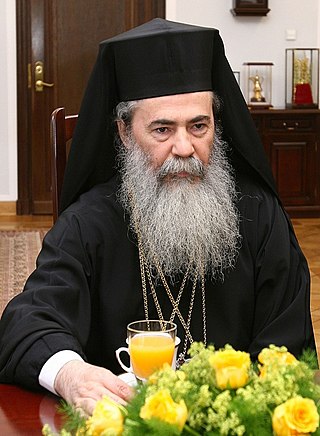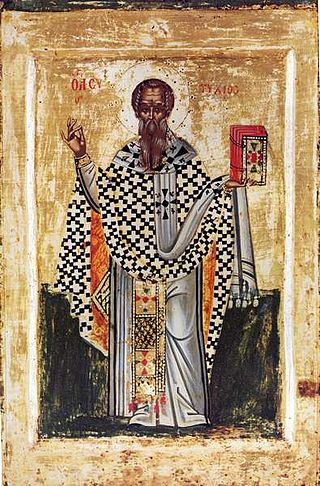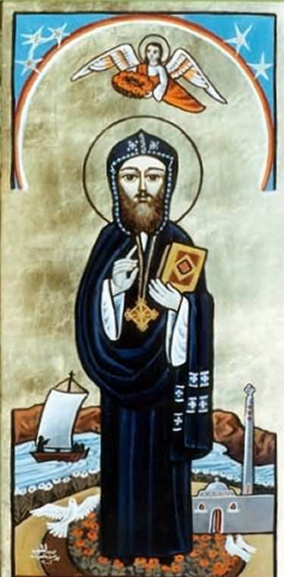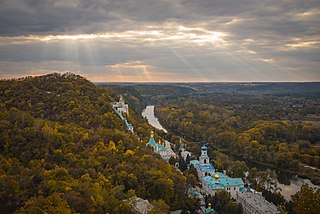Related Research Articles

The Greek Orthodox patriarch of Jerusalem or Eastern Orthodox patriarch of Jerusalem, officially patriarch of Jerusalem, is the head bishop of the Greek Orthodox Patriarchate of Jerusalem, ranking fourth of nine patriarchs in the Eastern Orthodox Church. Since 2005, the Eastern Orthodox patriarch of Jerusalem has been Theophilos III. The patriarch is styled "Patriarch of the Holy City of Jerusalem and all Holy Land, Syria, beyond the Jordan River, Cana of Galilee, and Holy Zion." The patriarch is the head of the Brotherhood of the Holy Sepulchre, and the religious leader of about 130,000 Eastern Orthodox Christians in the Holy Land, most of them Palestinian Christians in Israel and Palestine.

Menas, considered a saint in the Calcedonian affirming church and by extension both the Eastern Orthodox Church and Roman Catholic Church of our times, was born in Alexandria, and enters the records in high ecclesiastical office as presbyter and director of the Hospital of Sampson in Constantinople, where tradition has him linked to Saint Sampson directly, and in the healing of Justinian from the bubonic plague in 542. He was appointed Patriarch of Constantinople by the Byzantine emperor Justinian I on 13 March 536. Pope Agapetus I consecrated him to succeed Anthimus, who was condemned as a monophysite. This was the first time that a Roman Pope consecrated a Patriarch of Constantinople.

Eutychius, considered a saint in the Catholic and Eastern Orthodox Christian traditions, was the patriarch of Constantinople from 552 to 565, and from 577 to 582. His feast is kept by the Orthodox Church on 6 April, and he is mentioned in the Catholic Church's "Corpus Juris". His terms of office, occurring during the reign of Emperor Justinian the Great, were marked by controversies with both imperial and papal authority.

Severus the Great of Antioch, also known as Severus of Gaza or the Crown of Syrians, was the Patriarch of Antioch, and head of the Syriac Orthodox Church, from 512 until his death in 538. He is venerated as a saint in the Oriental Orthodox Church, and his feast day is 8 February.
The Three-Chapter Controversy, a phase in the Chalcedonian controversy, was an attempt to reconcile the non-Chalcedonians of Syria and Egypt with Chalcedonian Christianity, following the failure of the Henotikon. The Three Chapters that Emperor Justinian I anathematized were:
- The person and writings of Theodore of Mopsuestia
- Certain writings of Theodoret of Cyrus
- The letter of Ibas of Edessa to Maris

A lavra or laura is a type of monastery consisting of a cluster of cells or caves for hermits, with a church and sometimes a refectory at the center. Lavra monasteries operate within the Orthodox and other Eastern Christian traditions; the name is also used by some Catholic communities. The term in Greek initially meant a narrow lane or an alley in a city.

Pentarchy is a model of Church organization formulated in the laws of Emperor Justinian I of the Roman Empire. In this model, the Christian Church is governed by the heads (patriarchs) of the five major episcopal sees of the Roman Empire: Rome, Constantinople, Alexandria, Antioch, and Jerusalem.
Philotheos Kokkinos was the Ecumenical Patriarch of Constantinople for two periods from November 1353 to 1354 and 1364 to 1376, and a leader of the Byzantine monastic and religious revival in the 14th century. His numerous theological, liturgical, and canonical works received wide circulation not only in Byzantium but throughout the Slavic Orthodox world.

Sabas (439–532), in Church parlance Saint Sabas or Sabbas the Sanctified, was a Cappadocian Greek monk, priest, grazer and saint, who was born in Cappadocia and lived mainly in Palaestina Prima. He was the founder of several convents, most notably the one known as Mar Saba, in Palestine. The saint's name is derived from Imperial Aramaic: סַבָּא Sabbāʾ "old man".

Eastern Christian monasticism is the life followed by monks and nuns of the Eastern Orthodox Church, Oriental Orthodoxy, the Church of the East and Eastern Catholicism. Eastern monasticism is founded on the Rule of St Basil and is sometimes thus referred to as Basilian.
In the history of Christianity, the first seven ecumenical councils include the following: the First Council of Nicaea in 325, the First Council of Constantinople in 381, the Council of Ephesus in 431, the Council of Chalcedon in 451, the Second Council of Constantinople in 553, the Third Council of Constantinople from 680–681 and finally, the Second Council of Nicaea in 787. All of the seven councils were convened in what is now the country of Turkey.
Saint Ephraim of Antioch, also known as Saint Ephraim of Amida, was the Patriarch of Antioch, and head of the Greek Orthodox Church of Antioch, from 527 until his death in 545. He is venerated as a saint in the Eastern Orthodox and Catholic Churches. His feast day is 8 June.
Paul II the Black, also known as Paul of Bēth Ukkāme, was the Patriarch of Antioch and head of the Syriac Orthodox Church from c. 551 or 564 to his deposition in 578. He succeeded Sergius of Tella as the spiritual leader of the Syrian non-Chalcedonians, in opposition to the Chalcedonian Imperial Church, and led the nascent Syriac Orthodox Church as it endured division and persecution.
This is a timeline of the presence of Eastern Orthodoxy in Greece from 717 to 1204. The history of Greece traditionally encompasses the study of the Greek people, the areas they ruled historically, as well as the territory now composing the modern state of Greece.

The Church of Sinai is a Greek Orthodox autonomous church whose territory consists of St. Catherine's Monastery at the foot of Mount Sinai in Egypt, along with several dependencies. There is a dispute as to whether the church is fully autocephalous or merely autonomous. The church is headed by the Archbishop of Mount Sinai and Raithu, who is traditionally consecrated by the Greek Orthodox Patriarch of Jerusalem and also serves as abbot for the monastery. The current hierarch is Archbishop Damian.

The Origenist crises or Origenist controversies were two major theological controversies in early Christianity involving the teachings of followers of the third-century Alexandrian theologian Origen.
Macarius II of Jerusalem was the Patriarch of Jerusalem for two periods from 544 to 552 and from 564 to 574. He was patriarch during the era of the Christological disputes in the latter part of the reign of emperor Justinian.
The Council of Constantinople was a conference of the endemic synod held in Constantinople, the capital of the Eastern Roman Empire, in May–June 536. It confirmed the deposition of the Patriarch Anthimus I of Constantinople and condemned three prominent anti-Chalcedonians living in Constantinople, causing the Emperor Justinian I to ban all four from the capital. The Council of Jerusalem held in September was convoked to condemn the same four as heretics. The condemned were the deposed Patriarch Severus of Antioch, the deposed Bishop Peter of Apamea and the monk Zoora.
The Council of Jerusalem of 536 was a meeting of Chalcedonian representatives of the church of the Three Palestines to condemn certain persons accused of the Monophysite heresy. It was convoked at the initiative the Roman emperor Justinian I following the forced resignation of the Patriarch Anthimus I of Constantinople in February or March, an event in which Pope Agapetus I had played the main role.